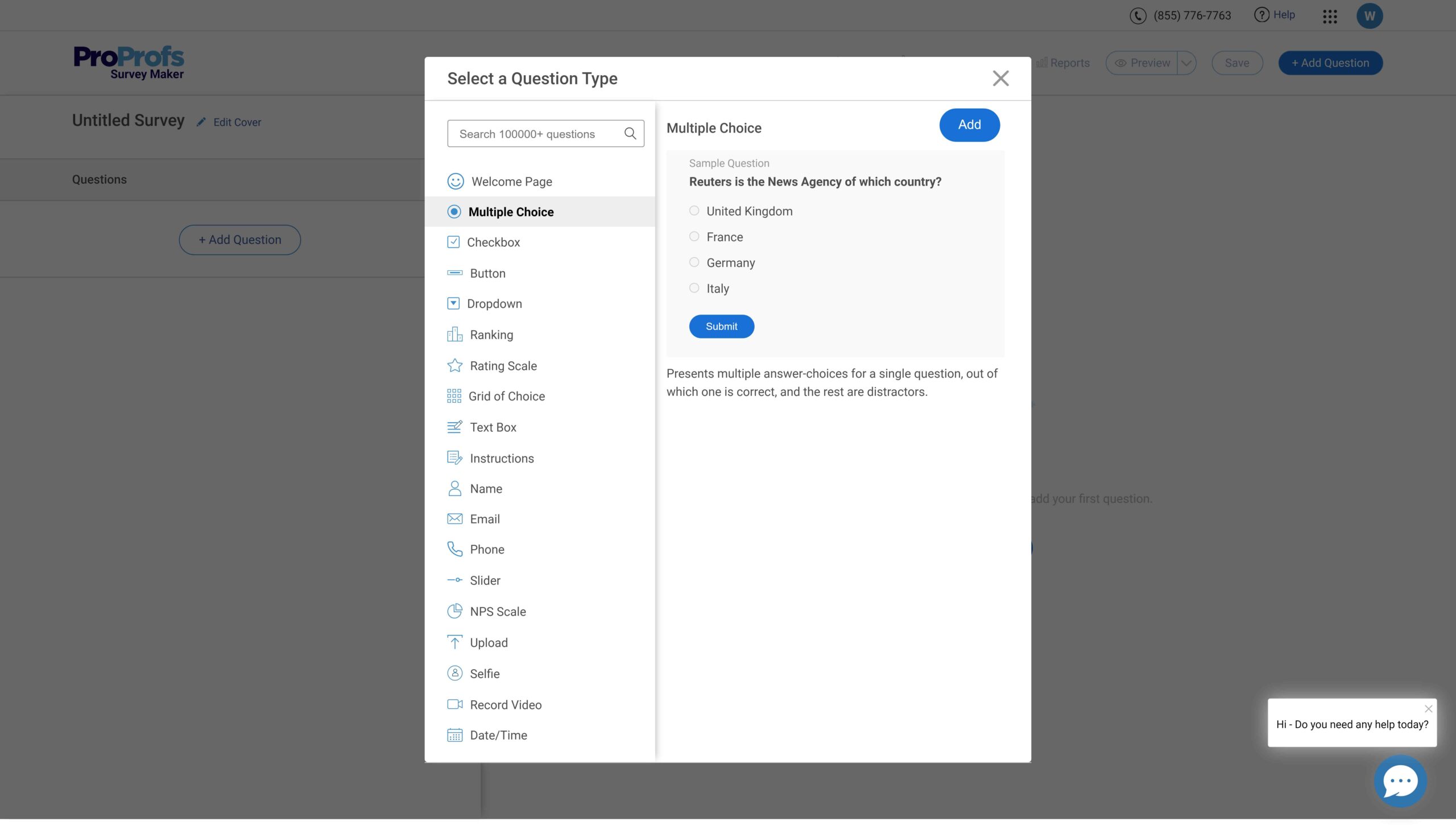For many employees, the traditional engagement survey feels like a chore: dozens of questions that don’t always feel relevant, and little confidence that results will lead to real change. Some rush through it, others skip it altogether, and many quietly wonder if their “anonymous” feedback is truly safe.
That gap is why employee engagement survey software matters in 2025. The problem isn’t the idea of surveys, it’s how outdated tools run them: clunky, overpriced, and more about glossy charts than real fixes. The new wave of software flips that script with pulse surveys that respect time, AI that makes sense of open feedback, and integrations that move insights straight into action.
This guide breaks down the best employee engagement survey software and shows how these tools can help you create an engaged and thriving workforce.
What Makes a Great Employee Engagement Survey Software in 2025
Before you compare platforms, know what makes an employee engagement survey tool effective. Many tools look good at first, but often cause survey fatigue, low participation, and results that never drive action. Here are the capabilities that set the best employee engagement survey platforms apart.
1. Ready-to-Use Templates & AI-Powered Survey Creation
Strong employee engagement survey software offers both ready-to-use templates and AI-powered survey creation. Templates save time and provide structure, while AI helps you frame better questions, reduce bias, and avoid fatigue. The platform should also support multimedia, customizable branding, and multiple formats such as pulse checks, annual reviews, onboarding and exit surveys, and 360 feedback. Skip logic and branching are critical so employees only see questions that apply to them.
2. Analytics That Turn Data Into Decisions
Data by itself does not create impact. The right employee engagement survey software uses AI to analyze open-text responses, identify themes, and measure sentiment. Real-time dashboards should alert you to trends as they happen. Benchmarking helps you understand where you stand against industry peers, while predictive analytics highlight risks before they escalate. Strong tools also categorize comments into themes, saving you time and giving you clear priorities.
3. Anonymity Employees Can Trust
Anonymity is one of the biggest concerns employees have about surveys, which is why organizations increasingly rely on anonymous surveys. A strong platform goes beyond removing names. Look for minimum reporting thresholds that prevent managers from seeing individual responses, suppression of timestamps that might reveal identity, and role-based access that limits who sees what.
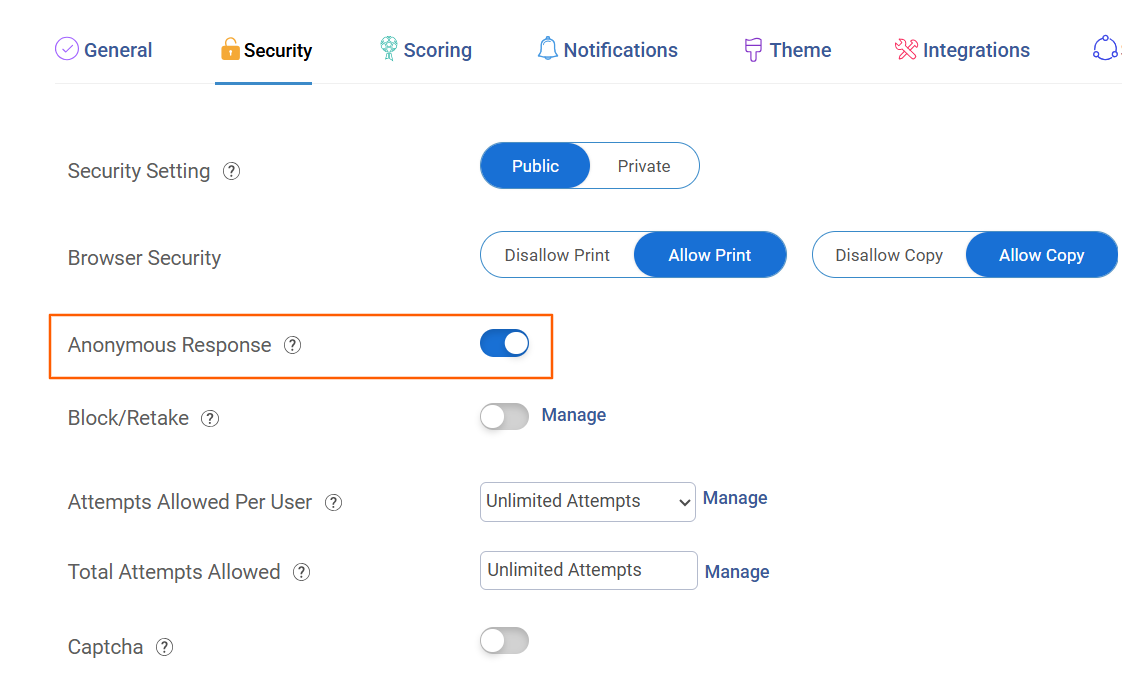
The best employee engagement survey platforms also use secure sign-on, comply with privacy standards, and clearly explain to employees how their data is protected. Without trust, you will not get honest feedback.
4. Feedback That Leads to Action
Engagement surveys are meaningless if nothing happens after results are collected. The strongest tools offer built-in action planning, resources for managers, automated reminders, and progress tracking. Some even prompt managers to start conversations when specific issues arise. When employees see visible changes, they are more likely to participate and share openly in future surveys.
5. Integration With the Systems You Already Use
Your survey platform should connect seamlessly with the systems you rely on. That includes HRIS for employee data, collaboration tools like Slack or Teams for survey distribution, and performance management systems for a complete view of engagement. API capabilities are also important so that you can link engagement data with business intelligence tools as your needs evolve.
6. Accessibility for Every Employee
A good survey platform is one that every employee can use. Mobile optimization, multilingual support, and varied distribution methods like email links, QR codes, or intranet embeds ensure broad participation. Inclusive design matters too, covering accessibility for those with visual impairments, limited internet access, or different levels of digital literacy.
7. Support That Sets You Up for Success
The best employee engagement survey software comes with support that feels like a partnership. You should expect onboarding guidance, expert advice on survey design, and continuous help as your engagement program grows. A reliable vendor helps you avoid common mistakes and ensures your surveys create a lasting impact.
The 9 Best Employee Engagement Survey Software of 2025
While selecting these tools, I relied on my experience, inputs from industry peers, software review sites, and customer testimonials & ratings.
1. ProProfs Survey Maker – Best for Easily Creating & Conducting NPS & CSAT Surveys
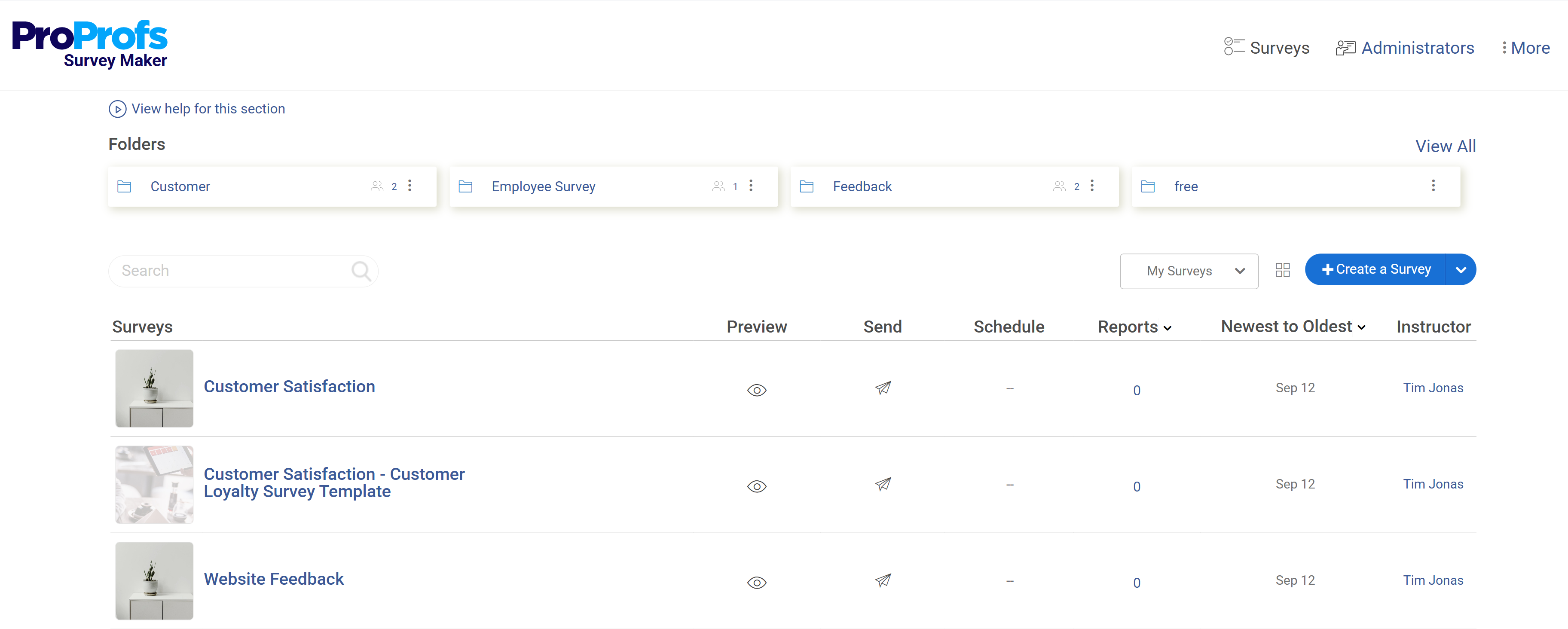
I’ve used ProProfs Survey Maker within my team, and what I found helpful is how it balances structure with flexibility. The platform comes with a wide range of templates, and the AI survey creation feature makes it easier to frame clear, relevant questions without overthinking. When I needed to explore specific issues like job satisfaction, motivation, or training effectiveness, building surveys felt straightforward.
It also gave me room to make feedback more engaging. Adding polls and quizzes encouraged participation, and the reporting made it simple to see where patterns or concerns were emerging. The interface is straightforward, and its focus on both ease of creation and depth of feedback makes it useful in practice.
Pros:
- AI-powered survey creation with smart question suggestions
- A comprehensive library of ready-to-use questions for different types of surveys
- 100+ professionally designed templates and a drag-and-drop feature to create or edit surveys in minutes
- Customization options to add your logo, colors, images, videos, and graphics to your surveys
- Scored questionnaires to assign points, rates, grades, or values to the feedback or answers
- Advanced reports and intelligent analytics to see who took your survey, how they answered, and more
- Integration with CRM and marketing automation software to follow up with your respondents easily
Cons:
- The interface looks a bit dated and may not appeal to some users
- Very few features are available in the basic version, and integrations can be costly
Pricing:
A free plan is available for up to 50 responses. Paid plan starts at $19.99/month.
Watch: 6 Quick Tips to Create Awesome Employee Engagement Surveys
2. Officevibe – Best for Overall Employee Assessment
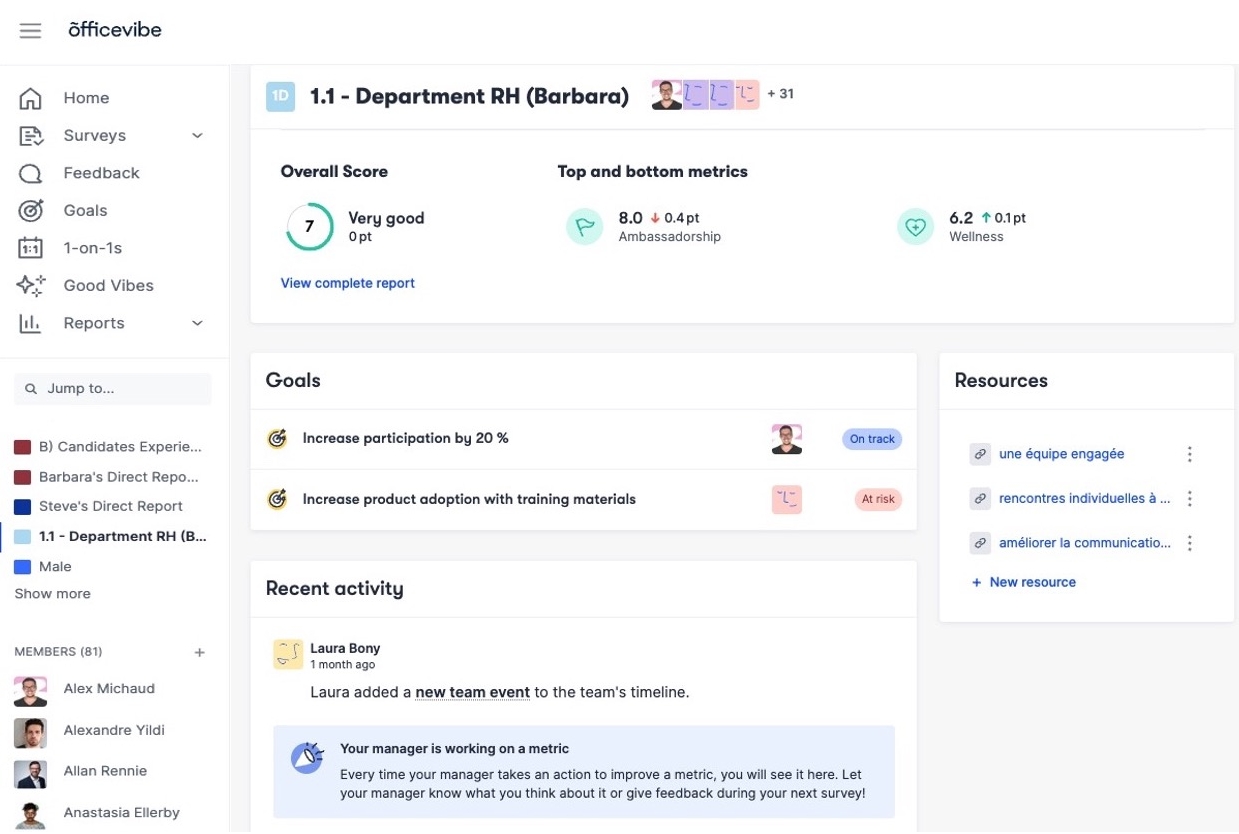
Source: Officevibe
Officevibe is an employee experience platform designed to boost engagement and performance. It provides tools for pulse surveys, eNPS scoring, anonymous feedback and messaging, performance reviews, goals and OKRs, and one-on-one meetings.
I was extremely impressed by its employee recognition feature, which enables peer-to-peer recognition and promotes a positive work culture.
The pulse surveys are designed to dive deep into specific areas of interest, such as work-life balance, communication, leadership, and personal development.
With carefully crafted questions and customizable survey templates, OfficeVibe allows organizations to collect feedback on important aspects that directly impact employee experience and engagement.
Pros:
- Intuitive tools for employee engagement, including pulse surveys, feedback, and recognition
- Helps evaluate employee performance with reviews and goal-setting
- Supports managers with resources for leading remote and hybrid teams
- Seamless integrations with Slack, Yammer, Microsoft Teams, Office 365, and Google
Cons:
- Lacks extensive customization options and survey creation tools
- Some questions aren’t customizable
Pricing:
Free plan available without templates, segmentation, data exporting, etc. Paid options start at $3.50/month.
3. Motivosity – Best for Employee Recognition And Appreciation
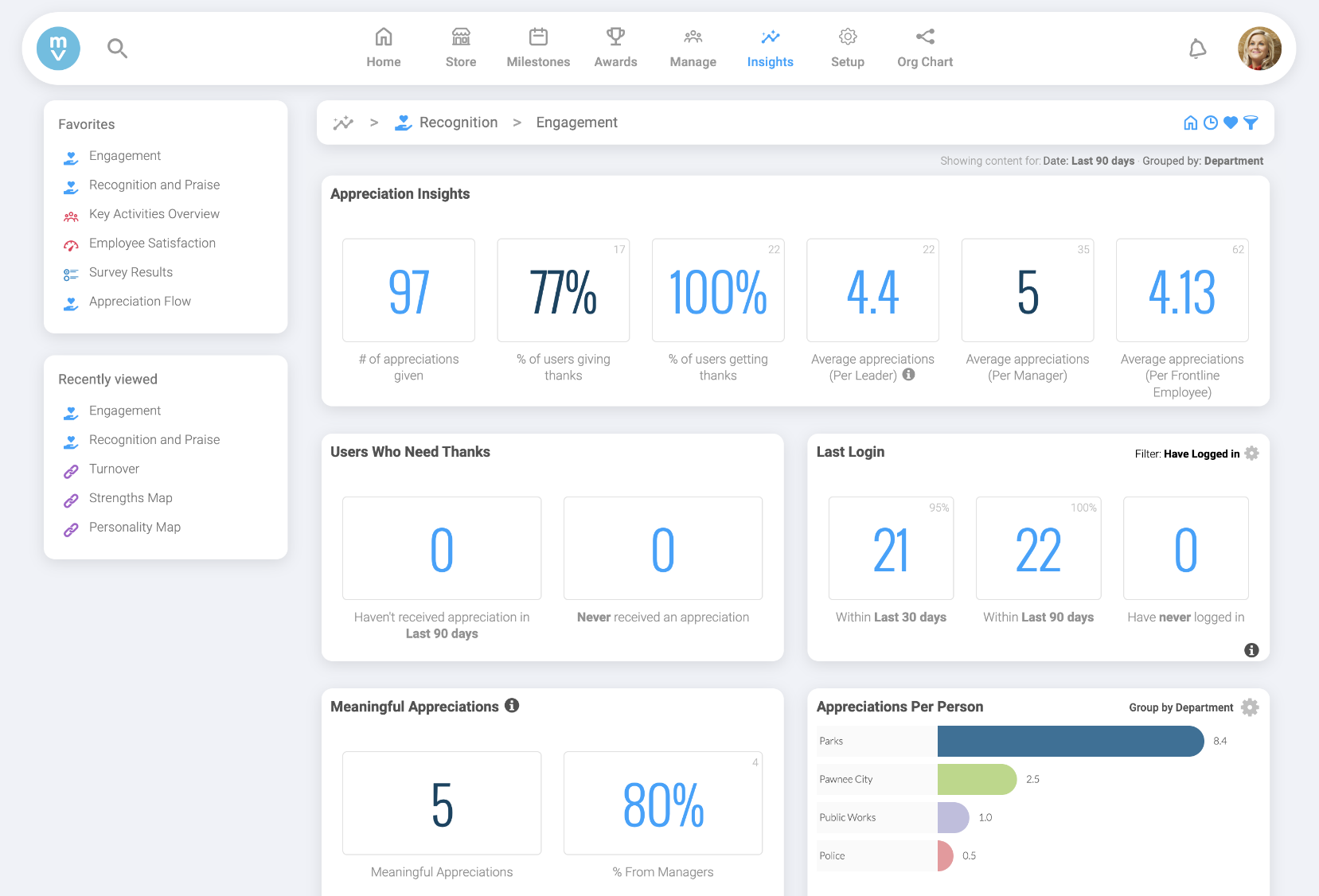
Source: Motivosity
If you want to create a culture of employee appreciation in your organization, I would say Motivosity is a good option to consider.
It is an excellent employee engagement platform that helps you recognize, reward, celebrate, communicate, learn, and grow with your co-workers. It also acts as a social platform where employees can give each other small monetary bonuses for doing great things!
Motivosity has a great employee experience feature that helps create and access personalized learning paths, career plans, coaching sessions, and mentorship programs.
Last but not least, Motivosity has an amazing pricing feature that lets users mix and match based on requirements. It offers flexible plans for a single team, a department, or a whole company.
Pros:
- Peer recognition to foster appreciation among colleagues
- Social feed to encourage sharing updates and insights
- Reward points system for redeemable recognitions
- Customizable surveys to gather tailored feedback
- Analytics dashboard for engagement insights
Cons:
- The Android mobile app is glitchy and unreliable
- The support team is hard to reach and only accessible through a web form
Pricing:
Starts at $2/user/month
4. Leapsome – Best for Employee Evaluation
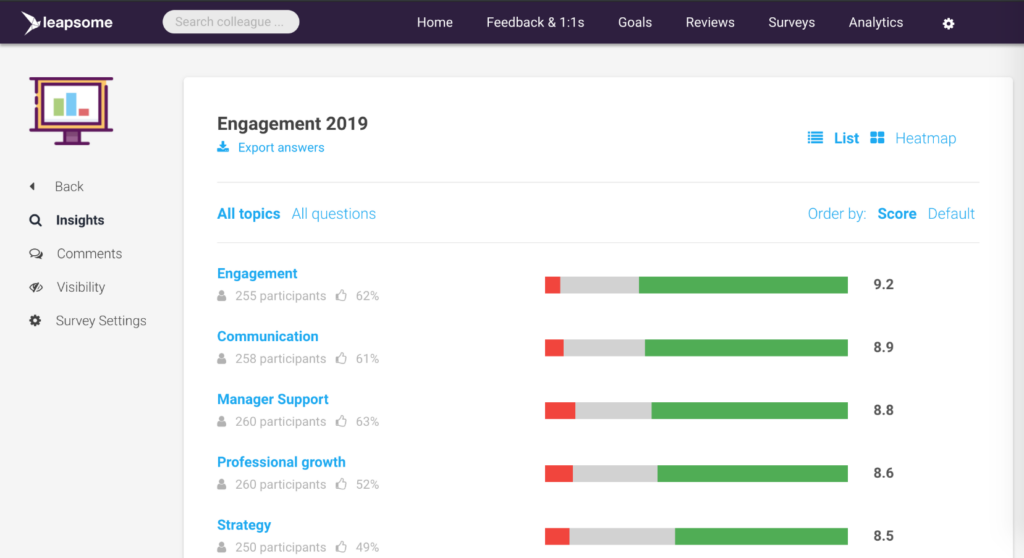
Source: Leapsome
Leapsome is a comprehensive platform that offers solutions for performance management, employee engagement, learning and development, and people analytics.
One of the things I like most about Leapsome is the performance management program. It allows me to set and track my goals, get feedback from my managers and peers, and have meaningful conversations about my progress and development.
Leapsome also has a great learning and development program that can create and access personalized learning paths, courses, quizzes, and micro-learnings.
Pros:
- A simplified and automated performance review process
- Continuous employee tracking and feedback mechanism
- Employee engagement that is measured and improved with surveys and actions
- Personalized learning paths for employees
- A recognition and feedback culture that is fostered with praise, one-on-one sessions, and peer feedback
Cons:
- Limited customization options
- Minor issues and bugs in navigating the app
Pricing:
Starts at $8/user/month
5. WorkTango – Best for Employee Retention
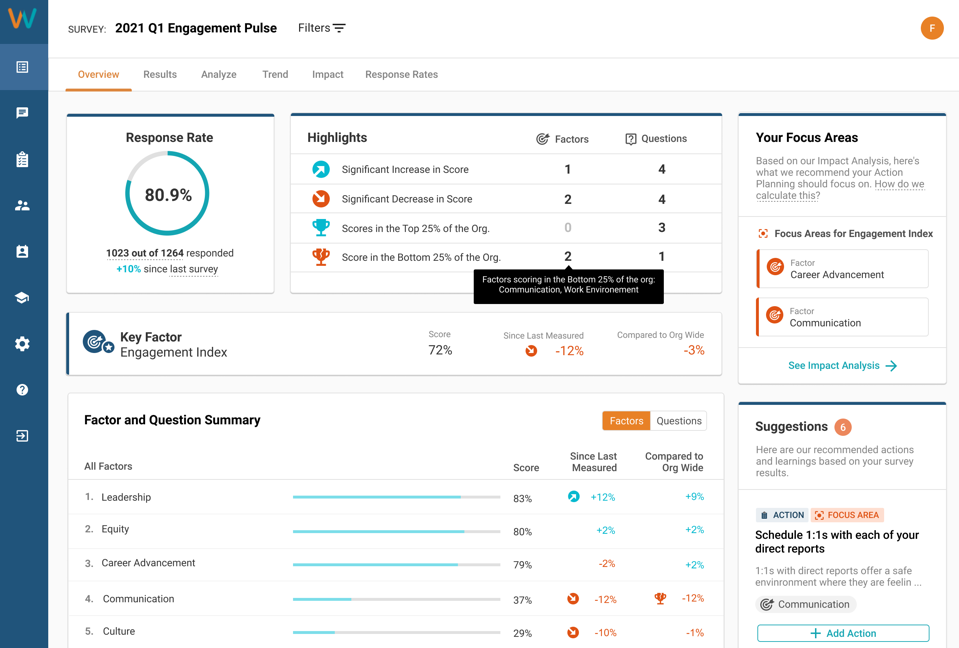
Source: Forbes
WorkTango helps build high-performing teams and empowers individuals to achieve their full potential by aligning professional development and fostering ongoing feedback conversations.
As a holistic employee experience and engagement platform, the tool provides a comprehensive solution to drive employee engagement and satisfaction.
Through its robust surveys and feedback mechanisms, the tool enables companies to gauge employee satisfaction and overall well-being, which, in turn, contributes to an increased employee retention rate.
Using its employee recognition & rewards platform, you can amplify and incentivize key values and behaviors, creating a culture of appreciation and alignment.
WorkTango also enables you to listen to employees with its employee surveys and insights, empowering leaders to take action based on real-time feedback and analytics.
Pros:
- Holistic Employee Experience platform driving engagement, satisfaction, and retention
- Employee Recognition and rewards fostering a culture of appreciation and alignment
- Employee Surveys and insights for authentic listening and actionable feedback
- Real-time feedback and analytics empowering leaders to take data-driven action
- Goals and feedback supporting employee success and professional development
Cons:
- The product does not venture into other HR functions like performance management or HRIS
- The reports are not intuitive or customizable
Pricing:
Minimum annual contract agreement of $8,000
6. WorkVivo – Best for Employee Communication
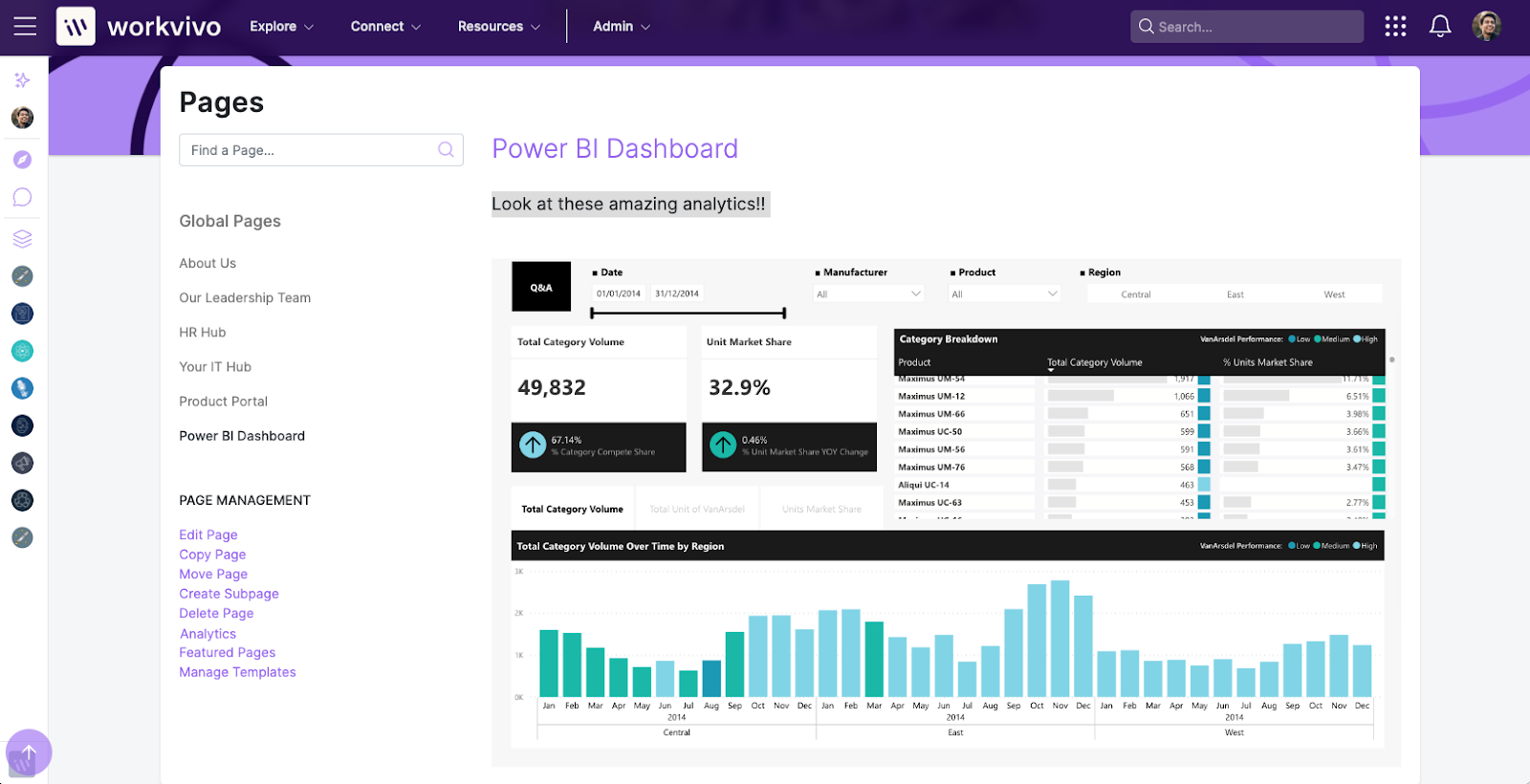
Source: WorkVivo
WorkVivo excels at bringing an organization’s culture, values, and goals to life in a fun, intuitive, and highly engaging way through features such as Livestream, video, news articles, podcasts, polls, surveys, and more.
The software goes beyond just a communication app – it is a platform that fosters a sense of belonging, recognition, and feedback among employees.
The tool improves employee communication and engagement, reduces staff turnover, increases productivity, and enhances collaboration. You can also easily share your achievements, celebrate your peers’ successes, and align your work with the organization’s vision and mission.
As I see it, Workvivo is a great tool for anyone who wants to make employee communication and engagement a smooth, hassle-free process.
Pros:
- Helps recognize fellow employees, celebrate their achievements, and connect their work to the company values and goals
- Fosters seamless interactions with colleagues through various channels, such as live streams, video, news articles, podcasts, and more
- Personalized activity feed where you can comment, post, like, and interact with the content
- Intranet to access all the information and resources you need in one place, such as company news, policies, events, etc.
- Insights that help you measure and improve employee sentiment through polls and surveys
Cons:
- It might be too robust for companies that only need a simple social media-style communication tool
- Not cost-effective for companies with fewer than 100 employees, as it has a minimum pricing structure
Pricing:
Custom quote
7. Qualtrics Employee Experience – Best for Experience Management
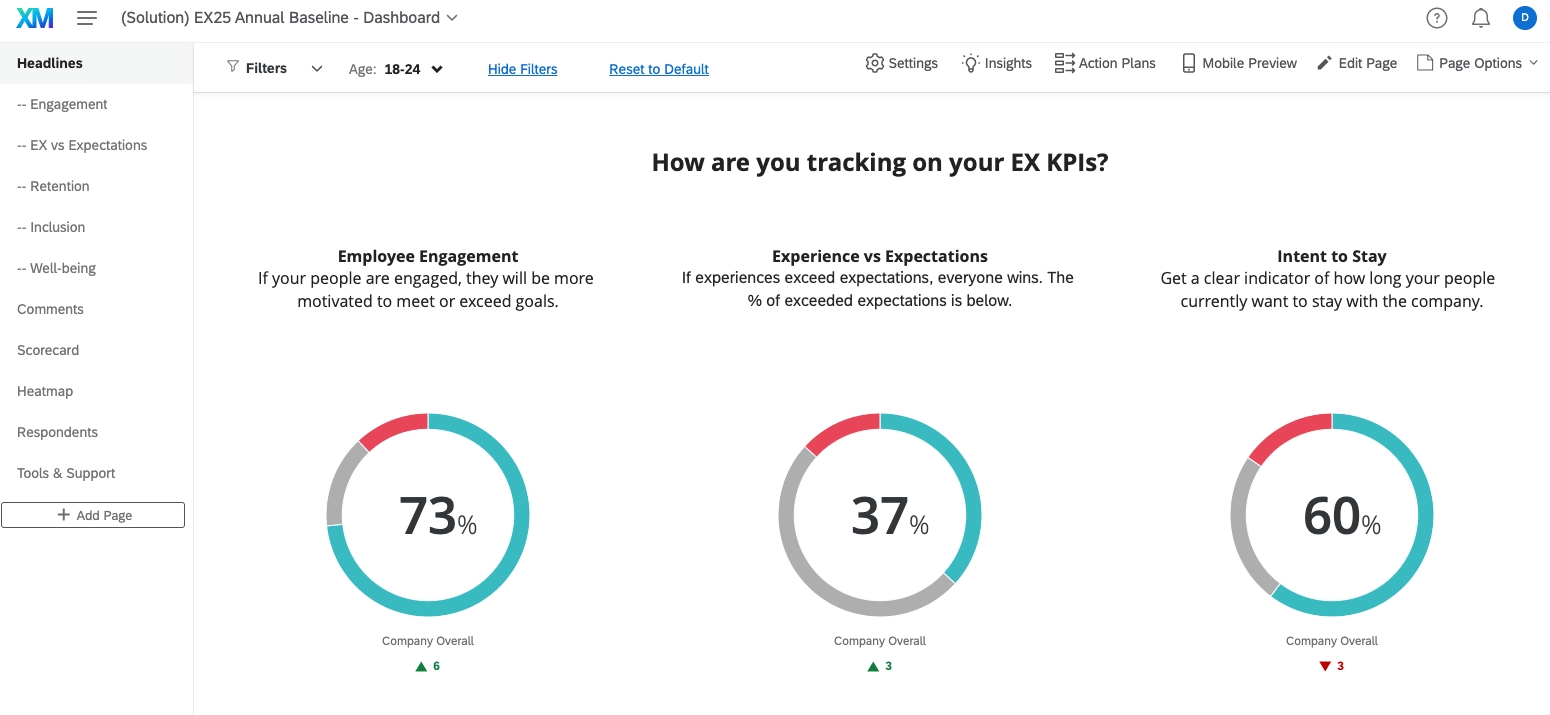
Source: Qualtrics
Qualtrics Employee Experience is yet another amazing software for enhancing employee engagement.
With personalized survey templates, I gain deep insights into sentiments and concerns, while the tool’s robust analytics engine provides real-time dashboards, allowing me to formulate targeted strategies.
What sets Qualtrics apart is its actionable insights – it not only identifies improvement areas but also facilitates seamless implementation and collaboration with colleagues. The sentiment analysis feature uncovers the sentiment behind open-ended responses, addressing underlying issues.
For those aiming to nurture a motivated and satisfied workforce, Qualtrics is the tool to achieve just that.
Pros:
- Multiple channels to collect feedback from employees, such as surveys, pulses, chatbots, digital interactions, and more
- Simple and intuitive way to understand the data and insights from the feedback
- Different dimensions to segment and visualize the data, such as department, location, tenure, etc.
- Progress and impact tracking and communication of the actions to the employees
- Ideas, resources, and support exchange with leaders who are committed to improving the employee experience
- Events, webinars, podcasts, blogs, and other learning opportunities to know the latest trends and best practices in the field
Cons:
- Steep learning curve – you may need some training and support to use the platform effectively and efficiently
- It can be expensive for small and medium-sized organizations
Pricing:
Custom quote
8. Sogolytics – Best for Learning & Feedback Management
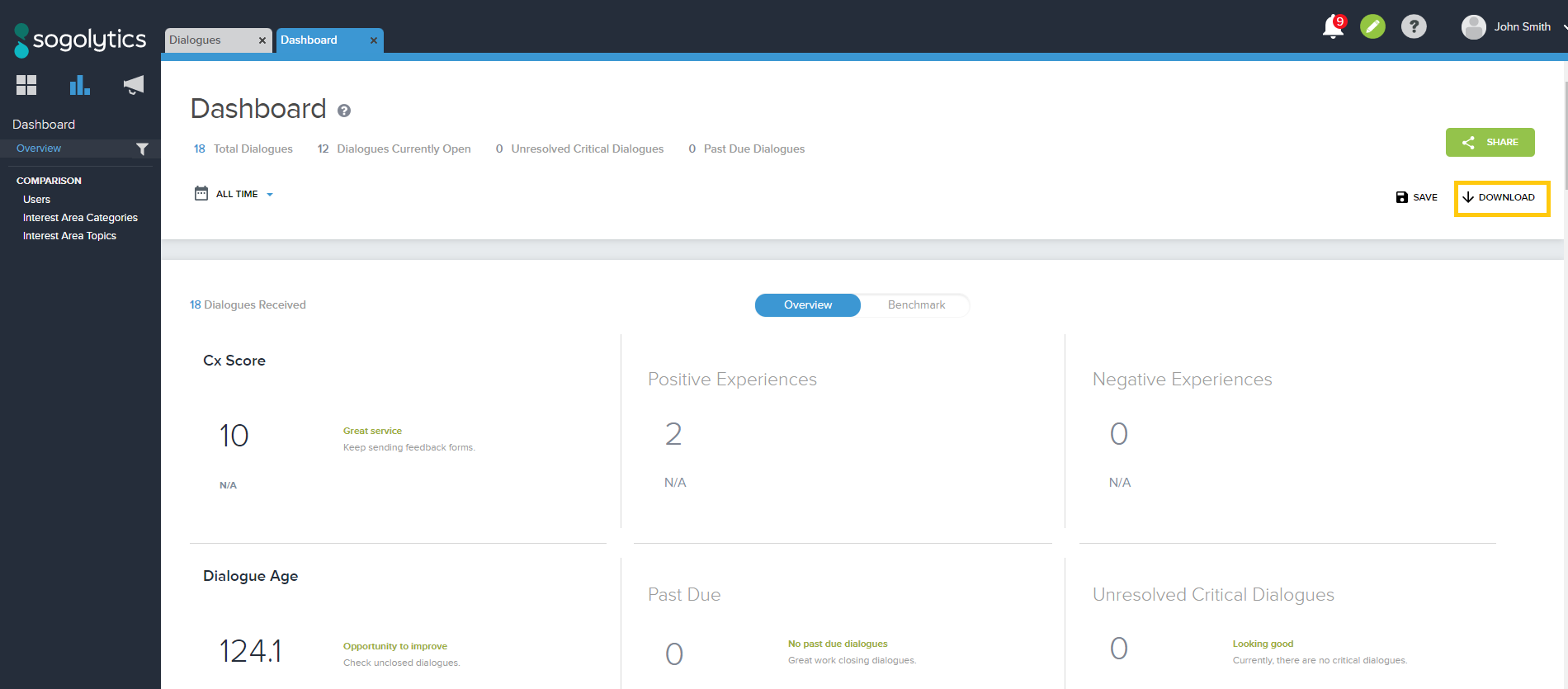
Source: Zarca
Sogolytics empowers organizations to create a positive work environment where employees thrive.
The tool features a suite of comprehensive learning tools such as surveys, eNPS, and 360-degree feedback to gather valuable insights, make data-driven decisions, identify drivers of engagement, and provide targeted learning and development opportunities.
In addition to learning and feedback management, Sogolytics offers features like employee recognition, HR analytics, and help desk ticketing.
It indeed shines at creating an environment that fosters a culture of appreciation, provides deep HR insights, and efficiently addresses employee inquiries, creating a highly engaged and satisfied workforce.
Pros:
- User-friendly interface and customizable templates to create surveys efficiently
- Easy distribution of surveys through email, social media, and embedded links
- Real-time data visualization, customizable dashboards, and advanced analytics for insightful survey reports
- Secure and efficient data export, integration, and advanced security measures
- Omnichannel feedback collection, alerts, actions, and integration with other enterprise systems
Cons:
- Limited customization options compared to other survey software
- The initial learning curve is quite steep
Pricing:
Starts at $25/month
9. SurveySparrow – Best for Highly Customizable Surveys
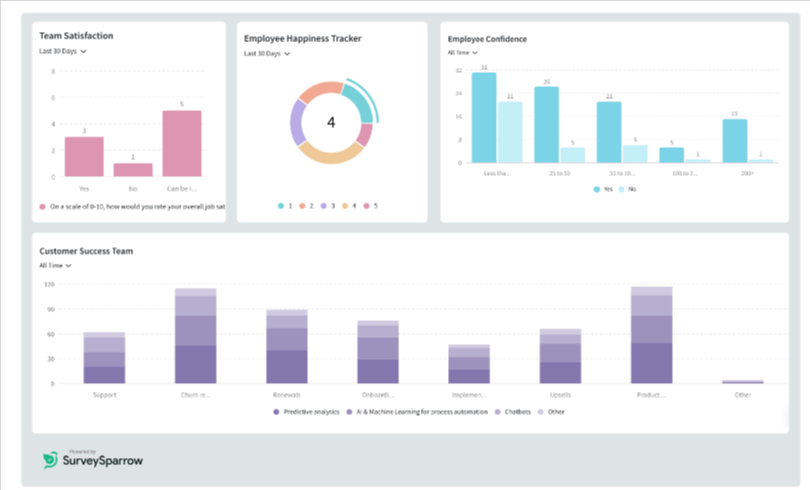
Source: SurveySparrow
SurveySparrow stands out as one of the top platforms I have used for creating interactive and engaging surveys.
The wide range of templates made it easy for me to fine-tune my survey experiences to align flawlessly with the goals of our feedback collection efforts.
The option to customize each survey’s closing message added a personal touch, while the automated deployment schedules ensured consistency.
From survey layout designs to language preferences, SurveySparrow places every element under your control, while the inclusion of features such as different question types, rating scales, and appealing images significantly enriches the survey-taking experience!
Pros:
- User-friendly interface with customizable and engaging survey options
- Rich analytics for gaining actionable insights
- Enables automation, offering recurring surveys that capture the mood of the employees continually
- Provides multi-channel sharing options for wider reach, such as, via emails, links, SMS, QR-codes, social media, and email embed codes
Cons:
- There might be a learning curve for non-tech-savvy users due to multiple customization options
- More comprehensive features come only with higher pricing plans
Pricing:
Basic plan for individuals start at $19/month
How to Choose the Right Employee Engagement Survey Software
Choosing employee engagement survey software is not about chasing features. It is about solving your real challenges and finding employee engagement survey tools that fit your culture, team size, and long-term goals. This framework will help you evaluate employee engagement survey platforms with clarity.
Step 1: Define Your Primary Challenges
Start with what is broken in your current approach.
- Low Completion Rates: Use survey software with mobile optimization, multiple distribution options, and engaging designs.
- Weak Anonymity: Select tools with strong privacy features, minimum reporting thresholds, and clear anonymity policies.
- No Action on Data: Prioritize platforms that offer action planning, manager dashboards, and progress tracking.
- Survey Fatigue: Look for employee engagement survey tools with pulse surveys, AI-assisted questions, and smarter timing.
- Global Workforce Needs: Ensure your software supports multiple languages, cultural adaptation, and timezone-friendly scheduling.
Step 2: Match Features to Your Goals
Different objectives call for different solutions.
- Culture Building: Tools with recognition features, social engagement, and culture-focused templates.
- Retention: Platforms with predictive analytics, lifecycle surveys, and exit interview integration.
- Manager Growth: Survey tools with manager dashboards, coaching resources, and 360 feedback.
- Performance Links: Employee engagement survey platforms that connect with performance systems and track engagement-performance metrics.
Step 3: Consider Your Organization’s Context
- Small Teams (Under 100): Simple, cost-effective tools that avoid enterprise-level complexity.
- Mid-Size (100–1000): Employee engagement survey software that scales while staying easy to use.
- Large Enterprises (1000+): Advanced analytics, strong integrations, and enterprise-grade security.
- Regulated Industries: Platforms with compliance features, certifications, and data governance.
Step 4: Prioritize Actionability
The question is not what your survey software measures, but how it drives action. Look for:
- Built-in action planning
- Manager development resources
- Progress tracking and reminders
- Tools to share updates with employees
Step 5: Check User Experience and Adoption
Even powerful survey platforms fail if employees or managers cannot use them. Test:
- The mobile and desktop survey-taking experience
- How easily managers can interpret dashboards
- Training requirements for adoption
Step 6: Test Before You Commit
Most employee engagement survey platforms offer free trials or demos. Use them to:
- Build a survey with your own questions
- Test analytics with sample data
- Assess integrations with your current systems
- Evaluate the responsiveness of customer support
Future Trends in Employee Engagement Survey Software (2025 and Beyond)
Employee engagement survey software is rapidly evolving as organizations face hybrid work, generational shifts, and declining trust in traditional surveys. The annual questionnaire is fading, replaced by platforms that use AI, personalization, and continuous listening to predict and prevent disengagement. Here are the trends shaping 2025 and beyond.
1. AI Moves From Analysis to Prediction
The strongest employee engagement survey tools are no longer reactive. AI can now analyze unstructured data from surveys, comments, and communications to flag risks before they spread. Predictive models help identify early signs of burnout, disengaged managers, or flight risk employees, giving leaders time to act. Beyond 2025, expect AI-driven assistants to automate feedback loops and integrate directly into enterprise systems, creating seamless human-AI collaboration.
2. Pulse Surveys Become Real-Time
Annual surveys are quickly becoming outdated. Modern employee engagement survey platforms embed micro-pulse surveys into daily workflows, from in-email polls to mobile prompts. This approach captures sentiment in real time, making it easier to respond quickly instead of waiting months. By 2026, continuous listening and even passive monitoring will become standard, aligning with employee expectations for frequent, meaningful feedback.
3. Personalization at Scale
Generic survey experiences are giving way to personalization. AI-driven platforms tailor surveys based on role, location, or engagement history, delivering questions that feel relevant. This personalization shortens onboarding, improves response rates, and increases trust. Looking forward, generative AI will create dynamic survey content that adapts to employee needs and values, especially for Gen Z workers who expect alignment with career growth and well-being.
4. Smarter Metrics and Dashboards
Organizations are moving from data overload to actionable insights. Employee engagement survey software now provides dashboards that connect engagement results with business metrics such as retention and productivity. Instead of being limited to HR leaders, these insights are shared more widely across teams, helping managers take immediate action. Future platforms will evolve into full “systems of intelligence,” where AI surfaces culture trends directly from organizational data.
5. Ethical AI and Building Trust
With AI adoption accelerating, employees want to know their data is safe. The next wave of employee engagement survey tools will focus on transparency, ethical AI practices, and clear communication about how feedback is used. Features such as anonymous channels, secure reporting, and balanced 360-degree feedback will help protect trust. Long-term, successful platforms will combine AI-driven insights with human empathy, ensuring technology supports rather than replaces leadership.
6. Multichannel Ecosystems
Employee engagement survey platforms are expanding beyond surveys to become engagement ecosystems. Integration with mobile apps, chat tools, wellness platforms, and recognition systems makes feedback part of daily work rather than a yearly exercise. By 2030, analysts expect these ecosystems to redefine how organizations deliver employee value propositions, blending engagement, culture, and learning into one experience.
The Takeaway
These shifts are not simple upgrades. They are necessary changes to match the way people now work and expect to be heard. Organizations that embrace AI-driven insights, personalization, and trust-centered design will turn surveys into genuine growth drivers instead of compliance exercises.
FREE. All Features. FOREVER!
Try our Forever FREE account with all premium features!
Transforming Feedback Into Cultural Change
Choosing the right employee engagement survey software is only the first step. The real impact comes when these tools spark continuous conversations and lead to visible improvements. The best employee engagement survey platforms share the same DNA: they protect employee trust, turn data into clear actions, and support long-term cultural growth rather than one-off reports.
Your choice should reflect your organization’s size, industry, and goals. A startup may need simplicity and speed, while a global enterprise demands scalability, compliance, and advanced analytics. What matters most is not the feature checklist but whether the software integrates seamlessly into daily work so feedback feels natural, not forced.
ProProfs Survey Maker, for example, helps HR teams and managers move past stale, one-time surveys by making it easy to collect honest input, analyze trends in real time, and show employees that their voices matter.
The organizations that thrive this year will be those that listen consistently, respond quickly, and build cultures where employees feel valued. The right survey tool provides the foundation, but your commitment to acting on insights creates the change.
FREE. All Features. FOREVER!
Try our Forever FREE account with all premium features!

 We'd love your feedback!
We'd love your feedback!
 Thanks for your feedback!
Thanks for your feedback!


